In our previous blog post we had discussed about What is Screen Flows In Salesforce.In these blog post we discuss about Record Triggered Flow in Salesforce
Contents
- 1 Understanding Salesforce Flows
- 2 Introduction to Record Triggered Flow
- 3 Setting Up Record Triggered Flow
- 4 Components of a Record Triggered Flow
- 5 Creating a Simple Record Triggered Flow
- 6 Advanced Features of Record Triggered Flow
- 7 Best Practices for Designing Record Triggered Flows
- 8 Common Use Cases
- 9 Testing and Debugging
- 10 Deploying Record Triggered Flows
- 11 Monitoring and Maintenance
- 12 Security Considerations
- 13 Comparison with Other Automation Tools
- 14 Conclusion
- 15 FAQs
Record Triggered Flow in Salesforce
Understanding Salesforce Flows
Before we delve into Record Triggered Flows, it’s essential to understand the broader concept of Salesforce Flows. Salesforce Flows are automation tools that guide users through a series of screens to collect and update data. They come in different types, each serving unique purposes:
- Screen Flows: Used for user interactions and data collection through a series of screens.
- Auto-launched Flows: Triggered by platform events, processes, or Apex, running in the background.
- Scheduled Flows: Executed at specified times to perform routine tasks.
- Record Triggered Flows: Activated when a record is created, updated, or deleted.
Introduction to Record Triggered Flow
Record Triggered Flow Simply put, it’s a flow that automatically executes when a record undergoes changes. Whether it’s an update, creation, or deletion, the flow springs into action based on specified criteria. This makes it incredibly useful for tasks that require immediate responses to data changes, such as updating related records, sending notifications, or initiating approval processes.
Setting Up Record Triggered Flow
Prerequisites
Before you start creating Record Triggered Flows, ensure you have:
- Salesforce Admin Permissions: Necessary to create and manage flows.
- Understanding of Flow Basics: Familiarity with creating and managing basic flows in Salesforce.
Step-by-Step Setup Guide
Login in Salesforce Account

Click Gear icon Navigate Setup in Salesforce
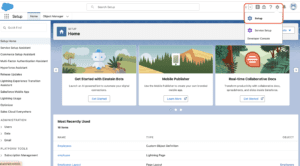
Search Quick find box enter Flows
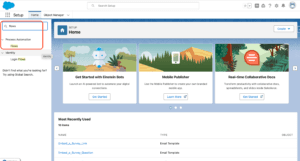
Click New Flow
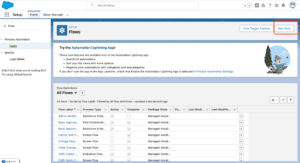
Select Record-Triggered flow in Salesforce
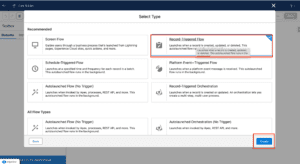
Configure select record creation or Update
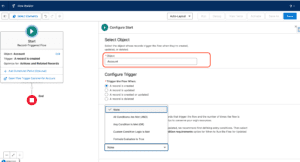
Set entry Conditions
Add flow elements like Assignment, Decision and Loops
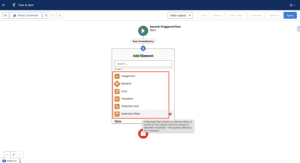
Click Save
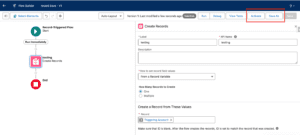
Components of a Record Triggered Flow
Triggers
The trigger determines when the flow should start. For instance, you can set it to trigger on record creation, update, or deletion.
Variables
Variables store data that can be used throughout the flow. They can hold information about the triggering record or any other data needed for the flow’s logic.
Elements
Elements are the building blocks of the flow. They perform actions like creating records, updating fields, or sending emails.
Decision Nodes
Decision nodes allow the flow to branch based on certain conditions. This enables more complex logic and dynamic actions.
Creating a Simple Record Triggered Flow
Let’s create a simple Record Triggered Flow to illustrate its power.
Example Scenario
Imagine you want to automatically update a related record when an Opportunity is closed won.
Detailed Walkthrough
- Create a New Flow: Start by creating a new Record-Triggered Flow.
- Set Trigger: Configure the trigger for when an Opportunity record is updated.
- Add Conditions: Specify conditions (e.g., Stage = “Closed Won”).
- Add Actions: Use elements to update the related Account record with new data.
- Save and Activate: Save the flow and activate it to see it in action.
Advanced Features of Record Triggered Flow
Loops
Loops allow you to perform actions on multiple records. For example, you can update all related records in a loop.
Subflows
Subflows enable you to call other flows within a main flow, promoting reusability and modularity.
Fault Paths
Fault paths handle errors and exceptions, ensuring your flow can gracefully manage unexpected issues.
Best Practices for Designing Record Triggered Flows
Performance Considerations
- Optimize Conditions: Use specific conditions to limit the flow’s execution to relevant records.
- Minimize Complexity: Avoid overly complex flows that can impact performance.
Error Handling
- Use Fault Paths: Always include fault paths to manage errors.
- Log Errors: Capture and log errors for troubleshooting.
Maintenance Tips
- Document Flows: Keep documentation for each flow to simplify maintenance.
- Regular Reviews: Periodically review and optimize flows for performance and relevance.
Common Use Cases
Updating Related Records
Automatically update related records based on changes in a parent record.
Sending Notifications
Send email or in-app notifications when specific record changes occur.
Automating Approval Processes
Kick off approval processes when records meet certain criteria.
Testing and Debugging
Testing Tools and Techniques
- Use Debug Mode: Test flows in debug mode to step through the logic.
- Test Data: Use test data to validate flow actions.
Debugging Common Issues
- Check Conditions: Ensure conditions are correctly specified.
- Review Error Logs: Analyze error logs to identify issues.
Deploying Record Triggered Flows
Change Sets
Use change sets to deploy flows between environments.
Metadata API
Leverage the Metadata API for more advanced deployment options.
Salesforce CLI
Use Salesforce CLI for scripting and automating deployments.
Monitoring and Maintenance
Monitoring Flow Performance
Regularly monitor flow performance to identify and address issues.
Regular Maintenance Activities
Perform routine maintenance to ensure flows remain efficient and effective.
Security Considerations
User Permissions
Ensure users have the necessary permissions to interact with flows.
Data Access Controls
Implement data access controls to protect sensitive information.
Comparison with Other Automation Tools
Workflow Rules
Simpler but less powerful compared to flows.
Process Builder
Offers more features than workflow rules but less flexible than flows.
Apex Triggers
Highly customizable but requires coding skills.
Conclusion
Record Triggered Flows are a game-changer in Salesforce automation. They offer a powerful, flexible way to respond to data changes, ensuring your processes are efficient and responsive. As you master Record Triggered Flows, you’ll unlock new levels of automation and efficiency in your Salesforce org.
We want to more about Record Triggered Flow in Salesforce Click Here
FAQs
What are the limitations of Record Triggered Flows?
While powerful, they may not handle highly complex logic as efficiently as Apex triggers.
How can I optimize flow performance?
Optimize conditions, minimize complexity, and regularly review and refine your flows.
Can Record Triggered Flows replace Apex Triggers?
In many cases, yes, but for highly complex logic, Apex triggers may still be necessary.
What are some common pitfalls to avoid?
Avoid overly complex flows, ensure proper error handling, and regularly test and review your flows.
How do I stay updated with new features?
Follow Salesforce release notes and participate in the Trailblazer Community for the latest updates.
In our next blog post we will discuss about What is Schedule-Triggered Flow
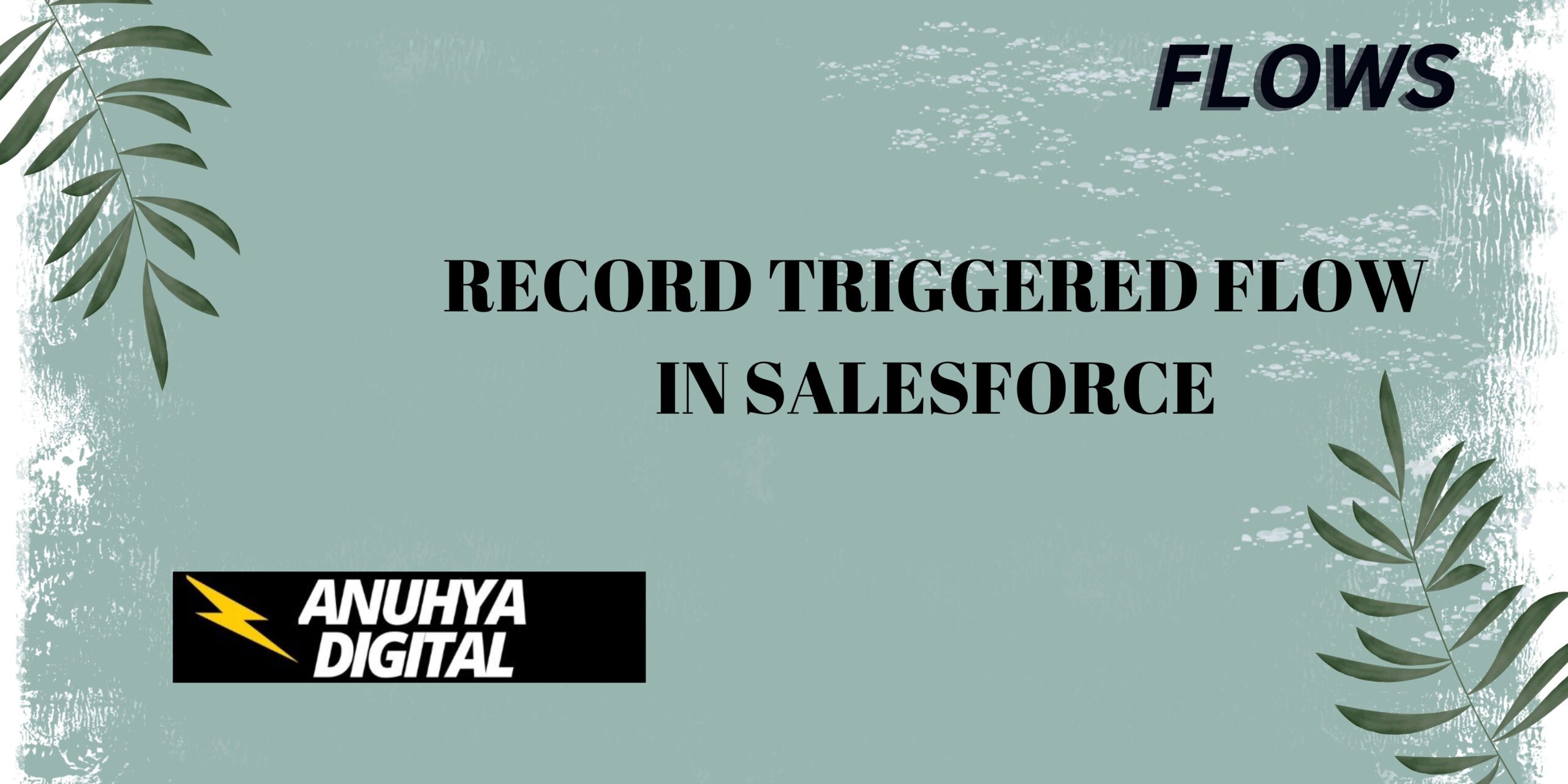
2 thoughts on “Record Triggered Flow in Salesforce”